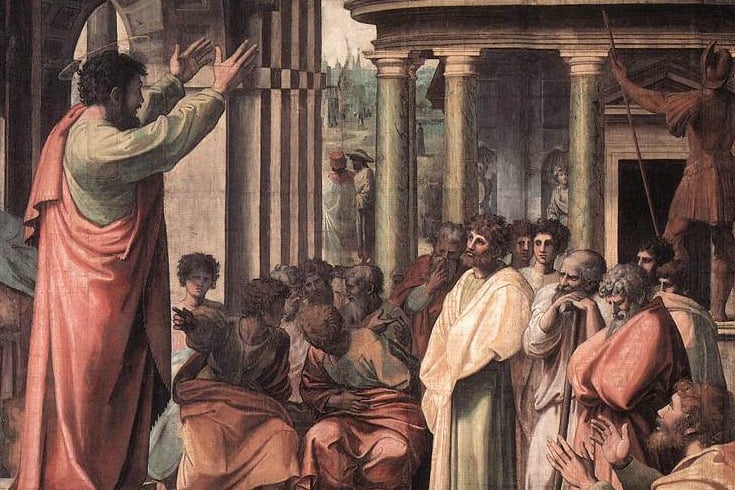I have in parts one and two of this series dedicated to improving Catholic homilies suggested two major pieces of advice. First, avoid homilies that are unfocused and difficult to absorb by driving home only one important point per homily. Second, avoid sentimental moralism by grounding every homily message in the Good News of what God has done for us as the foundation of anything we might need to do.
I might in addition suggest a handful of other ideas to help improve Catholic homilies. One would be simply to make time to prepare homilies. Priests are often so busy that preparing homilies can get short shrift. But focused preparation is essential to a good homily. I might also suggest keeping homilies to less than ten minutes long. There again, the adage “less is more” pertains when it comes to communicating a key point effectively.
But I think one other substantive suggestion is particularly important. Homilies should take advantage of opportunities to explain various parts of the Church’s liturgical practices throughout the Church year. Many priests may take for granted that parishioners understand the meaning of the various words, movements, colors, vestments, elements, and gestures of the liturgy. But many do not comprehend or appreciate them. Some Catholics surely understand what is going on in the liturgy. But many Catholics have only a vague idea, yet would never ask about it. Others are largely ignorant.
At the University of Notre Dame, I have the privilege of teaching many smart and accomplished undergraduate students from Catholic backgrounds. But many of them readily admit that they do not know what is going on during Mass. They grew up with it. It feels familiar. But they have little idea what any of it means. Nobody ever explained it, they report. So it’s all a mystery to them. That’s a problem.
Celebrating the Liturgy of the Word and Eucharist is the central practice of faith among the Church’s many practices. By definition, a practice in faith is a spiritually, theologically, morally significant repeated behavior. The role of the body and material elements in liturgy are crucial, of course. But so is understanding. Practices like the liturgy need in some real way to be significant and meaningful to those who participate in them. Otherwise, they become rote, empty behaviors. Liturgy certainly forms people, by God’s grace and Spirit. But liturgy’s formative power is enhanced when people learn its fuller meaning, its significance. That requires teaching.
I have observed parishes where the liturgy is continually being explained in subtle but enlightening and interesting ways. It does not take much. Simple reminders here and there of what we are doing in liturgy and why are usually enough. Priests in such parishes seem to love the liturgy, are proud of it, and want the faithful to enter into it deeply. Gradually, worshippers in such congregations become more literate about liturgy and more meaningfully involved in it. In an upward spiral of growth, I have observed that people’s understanding of, formation by, and participation and interest in the liturgy increases.
I have also observed parishes, however, where the meaning of the liturgy is not actively cultivated, where its beauty and power are seemingly not appreciated or highlighted. I have even witnessed priests who seem embarrassed by some of the elements involved in the liturgy. I remember one case in particular when a priest presiding at Mass in a major cathedral casually apologized for having to wear rose-colored vestments on Gaudete Sunday (the Third Sunday of Advent), saying that he felt uncomfortable “in pink,” so people could just ignore the vestments. Rather than being confidently invited into the rich meaning and power of the liturgy as it unfolds across the Church’s liturgical year, those in attendance were confused and alienated from it. We can do better.
My suggestion here is simple. When appropriate, priests should utilize their homilies well, creating opportunities to explain the abundant meanings of various parts of the liturgy, especially as related to particular times of the Church year. It simply cannot be taken for granted that people in attendance—especially young people—know and understand those meanings. They need to and can be taught in winsome, inviting, and compelling ways.
Does this third piece of advice for improving Catholic homilies undermine my first two suggestions? Not necessarily. Over a span of weeks, even months, it is entirely possible for a homilist to illuminate parts of the liturgy, while keeping each homily focused only on a single important point, weaving liturgy and Scripture together. Such explanations, rather than wandering off into distracting side points, can often indirectly or directly help to reinforce the homily’s central point. Over time, preaching that unites the Scriptural and liturgical life of the Church helps to convey a more comprehensive, integrated sense of what the Church and faith are all about.
Does the practice of explaining parts of the liturgy in homilies contradict my second suggestion, to avoid sentimental moralism by grounding every homily message explicitly in the Gospel? No. The liturgy and the Gospel are naturally interpenetrating. Thoughtfully prepared homilies can both explain the liturgy and ground their content in a Christocentric, Trinitarian message of new evangelization. Homilies of such a caliber are what will most effectively strengthen the faith and practice of the people of God.
In sum, instead of imagining that people in the pews understand the meaning of the Church’s liturgical practices—which many in fact do not—homilists should proactively seek appropriate opportunities to draw their hearers into a deeper understanding and appreciation of the meaning of the liturgy. Over time, this ought to produce a people more in love with the Church’s liturgy, sacraments, and worship—and therefore, more in love with God.
![]()
Editors’ Note: This article originally appeared in Church Life: A Journal for the New Evangelization, volume 1, issue 4.
Featured Image: Raphael Sanzio da Urbino (1483–1520), St. Paul Preaching in Athens (1515); courtesy Wikimedia Commons.



